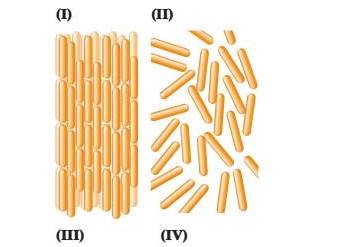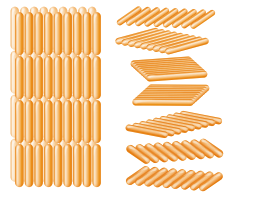
LCPO CHEMISTRY W/MODIFIED MASTERING
8th Edition
ISBN: 9780135214756
Author: Robinson
Publisher: PEARSON
expand_more
expand_more
format_list_bulleted
Concept explainers
Textbook Question
Chapter 11, Problem 11.19CP
The following compound undergoes a phase transition from the solid to the smectic liquid crystal phase at 121 °C. Upon further heating, the compound undergoes another transition to liquid phase at 131 °C.

(a) Which image represents the arrangement of molecules at 125
(b) Which image represents the arrangement of molecules at 135


Expert Solution & Answer
Want to see the full answer?
Check out a sample textbook solution
Students have asked these similar questions
Obtain 2-methylbutanoic acid by malonic or acetylacetic synthesis (indicate the formulas of the compounds involved).
EFFICIENTS
SAMPLE READINGS
CONCENTRATIONS
Pigiadient)
TOMATO SAUCE (REGULAR)
TOMATO (REDUCED SALT)
TOMATO SAUCE (REGULAR)
TOMATO (REDUCED SALT)
58
6.274
3.898
301.7
151.2
14150
5.277
3.865
348.9
254.8
B
5.136
3.639
193.7
85.9
605
4.655
3.041
308.6
199.6
05
5.135
3.664
339.5
241.4
0139
4.676
3.662
160.6
87.6
90148
5.086
3.677
337.7
242.5
0092
6.348
3.775
464.7
186.4
PART3
5.081
3.908
223.5
155.8
5.558
3.861
370.5
257.1
4.922
3.66
326.6
242.9
4.752
3.641
327.5
253.3
50
5.018
3.815
336.1
256.0
84
4.959
3.605
317.9
216.6
38
4.96
3.652
203.8
108.7
$3
5.052
3.664
329.8
239.0
17
5.043
3.767
221.9
149.7
052
5.058
3.614
331.7
236.4
5.051
4.005
211.7
152.1
62
5.047
3.637
309.6
222.7
5.298
3.977
223.4
148.7
5.38
4.24
353.7
278.2
5
5.033
4.044
334.6
268.7
995
4.706
3.621
305.6
234.4
04
4.816
3.728
340.0
262.7
16
4.828
4.496
304.3
283.2
0.011
4.993
3.865
244.7
143.6
AVERAGE
STDEV
COUNT
95% CI Confidence Interval (mmol/L)
[Na+] (mg/100 mL)
95% Na+ Confidence Interval (mg/100 mL)
If we have two compounds: acetone (CH₃COCH₃) and acetic acid (CH₃COOH), applying heat to them produces an aldol condensation of the two compounds. If this is correct, draw the formula for the final product.
Chapter 11 Solutions
LCPO CHEMISTRY W/MODIFIED MASTERING
Ch. 11 - Prob. 11.1PCh. 11 - The normal boiling point of water is 100.0 C, and...Ch. 11 - PRACTICE 11.1 The boiling point of ethanol is 78.4...Ch. 11 - APPLY 11.2 Chloroform CHCl3 has Hvap=29.2kJ/mol...Ch. 11 - How much heat is required to convert15.0 g of...Ch. 11 - APPLY 11.4 What is the sign and magnitude of q...Ch. 11 - Look at the phase diagram of H2O in Figure 11.7,...Ch. 11 - Prob. 11.8ACh. 11 - Why was a new solvent needed for extracting...Ch. 11 - A fire extinguisher containing carbon dioxide has...
Ch. 11 - Look at the phase diagram of CO2 in Figure11.13,...Ch. 11 - Liquid carbon dioxide is also used as non-toxic...Ch. 11 - For the phase transition CO2(s)CO2(g), predict the...Ch. 11 - A sample of supercritical carbon dioxide was...Ch. 11 - Assume that you have a liquid in a cylinder...Ch. 11 - The phase diagram of a substance is shown below....Ch. 11 - Prob. 11.17CPCh. 11 - Prob. 11.18CPCh. 11 - The following compound undergoes a phase...Ch. 11 - A magnetized needle gently placed on the surface...Ch. 11 - Water flows quickly through the narrow neck of a...Ch. 11 - Predict which substance in each pair has the...Ch. 11 - Prob. 11.23SPCh. 11 - The chemical structure for oleic acid, the primary...Ch. 11 - Prob. 11.25SPCh. 11 - Prob. 11.26SPCh. 11 - The vapor pressure of SiCI4 is 100 mm Hg at 5.4 C,...Ch. 11 - What is the vapor pressure of CS2 in mm Hg at 20.0...Ch. 11 - What is the vapor pressure of SiCI4 in mm Hg at...Ch. 11 - Dichloromethane, CH2CI2, is an organic solvent...Ch. 11 - Prob. 11.31SPCh. 11 - Use the plot you made in Problem 11.30 to find a...Ch. 11 - Prob. 11.33SPCh. 11 - Prob. 11.34SPCh. 11 - Prob. 11.35SPCh. 11 - Prob. 11.36SPCh. 11 - Acetone,acommon laboratorysolvent,has...Ch. 11 - Why is Hvap usually larger than Hfusion ?Ch. 11 - Why is the heat of sublimation, Hsubl, equal to...Ch. 11 - Naphthalene, better known as "mothballs," has bp =...Ch. 11 - Prob. 11.41SPCh. 11 - Prob. 11.42SPCh. 11 - Prob. 11.43SPCh. 11 - Prob. 11.44SPCh. 11 - Prob. 11.45SPCh. 11 - How much energy in kilojoules is needed to heat...Ch. 11 - Prob. 11.47SPCh. 11 - How much energy in kilojoules is released when...Ch. 11 - How much energy in kilojoules is released when...Ch. 11 - Prob. 11.50SPCh. 11 - Prob. 11.51SPCh. 11 - Prob. 11.52SPCh. 11 - Prob. 11.53SPCh. 11 - Prob. 11.54SPCh. 11 - Look at the phase diagram of H2O in Figure 11.7,...Ch. 11 - Prob. 11.56SPCh. 11 - Oxygen has Tt=54.3K,Pt=1.14mmHg,Tc=154.6K, and...Ch. 11 - Prob. 11.58SPCh. 11 - Prob. 11.59SPCh. 11 - Prob. 11.60SPCh. 11 - Prob. 11.61SPCh. 11 - Benzene has a melting point of 5.53 C and a...Ch. 11 - Prob. 11.63SPCh. 11 - How many phase transitions did you pass through in...Ch. 11 - Prob. 11.65SPCh. 11 - Prob. 11.66SPCh. 11 - Prob. 11.67SPCh. 11 - Prob. 11.68SPCh. 11 - Prob. 11.69SPCh. 11 - Prob. 11.70SPCh. 11 - Prob. 11.71SPCh. 11 - Prob. 11.72SPCh. 11 - Prob. 11.73SPCh. 11 - For each of the following substances, identify the...Ch. 11 - The chlorofluorocarbon refrigerant...Ch. 11 - Prob. 11.76MPCh. 11 - Prob. 11.77MP
Knowledge Booster
Learn more about
Need a deep-dive on the concept behind this application? Look no further. Learn more about this topic, chemistry and related others by exploring similar questions and additional content below.Similar questions
- If we have two compounds: acetone (CH3COCH3) and acetic acid (CH3COOH); if we apply heat (A), what product(s) are obtained?arrow_forwardQUESTION: Fill out the answers to the empty green boxes attached in the image. *Ensure you all incorporate all 27 values (per column)*arrow_forwardYou need to make a buffer by dissolving benzoic acid and sodium benzoate in water. What is the mass of benzoic acid that you would weigh out, in mg, to create 50 mL of a buffer at pH = 4.7 that will change pH no more than 0.10 units with the addition of 0.001 moles of acid or base? Enter just the answer without the units (mg) - just the number will do!arrow_forward
- Give the organic product: O A O B Ос ○ D -NH–CH3 + CH3 CH3 NEN C ? A CH3 CH3 NH- CH3 B CH3 CH3 N=N- C CH3 CH3 N=NNH CH3 D CH3 N=N CH3 NHCH3 LNH CHOarrow_forwardFinish the reaction- hand written pleasearrow_forwardGive the organic products: (benzyne) Br ? CH3 + K* :NH, liq NH3 HINT: Two products are formed. Each is a substituted aniline; they are isomers of each other. NH2 II I H₂N. CH3 CH3 III Select one: ○ A. I and II ○ B. I and III O C. I and IV O D. II and III O E. III and IV H₂N CH3 IV CH₂-NH2arrow_forward
- Predict the major products of this organic reaction: HBr (1 equiv) cold ? Some important notes: • Draw the major product, or products, of this reaction in the drawing area below. • You can draw the products in any arrangement you like. • Pay careful attention to the reaction conditions, and only include the major products. • Be sure to use wedge and dash bonds when necessary, for example to distinguish between major products that are enantiomers. • Note that there is only 1 equivalent of HBr reactant, so you need not consider the case of multiple additions. Erase something Explanation Check 2025 McGraw Hill LLC. All Rights Reserved. Terarrow_forwardQ14. Fill this chart: (please refer to ppt notes/browser to answer these questions) What alcohol is also called wood alcohol? What is the common name of ethanol? Draw the structure of phenol and thiophene? Are bigger chain alcohol like heptanol and octanol are soluble or insoluble in water and explain it ? Are ethers soluble or insoluble in water? What suffix and prefix are used for alcohol while naming alcohol and ether? What the process called when we add water to any alkene to make alcohol? Q16. Draw the diagram of following aromatic compound (practice from previous module) Aniline Phenol Benzoic acid Methyl benzoate Q17. a. Write the oxidation reactions for the 2 propanol. b. Write the oxidation reaction of the ethanol.arrow_forwardQuestion 11 of 18 (1 point) Question Attempt: 3 of How many signals do you expect in the 'H NMR spectrum for this molecule? Br Br Write the answer below. Also, in each of the drawing areas below is a copy of the molecule, with Hs shown. In each copy, one of the H atoms is colored red. Highlight in red all other H atoms that would contribute to the same signal as the H already highlighted red. Note for advanced students: In this question, any multiplet is counted as one signal. Number of signals in the 'H NMR spectrum. 1 For the molecule in the top drawing area, highlight in red any other H atoms that will contribute to the same signal as the H atom already highlighted red. If no other H atoms will contribute, check the box at right. No additional Hs to color in top molecule Check For the molecule in the bottom drawing area, highlight in red any other H atoms that will contribute to the same signal as the H atom already highlighted red. If no other H atoms will contribute, check the box…arrow_forward
arrow_back_ios
SEE MORE QUESTIONS
arrow_forward_ios
Recommended textbooks for you
 Chemistry: The Molecular ScienceChemistryISBN:9781285199047Author:John W. Moore, Conrad L. StanitskiPublisher:Cengage Learning
Chemistry: The Molecular ScienceChemistryISBN:9781285199047Author:John W. Moore, Conrad L. StanitskiPublisher:Cengage Learning Introductory Chemistry: A FoundationChemistryISBN:9781337399425Author:Steven S. Zumdahl, Donald J. DeCostePublisher:Cengage Learning
Introductory Chemistry: A FoundationChemistryISBN:9781337399425Author:Steven S. Zumdahl, Donald J. DeCostePublisher:Cengage Learning Principles of Modern ChemistryChemistryISBN:9781305079113Author:David W. Oxtoby, H. Pat Gillis, Laurie J. ButlerPublisher:Cengage Learning
Principles of Modern ChemistryChemistryISBN:9781305079113Author:David W. Oxtoby, H. Pat Gillis, Laurie J. ButlerPublisher:Cengage Learning General Chemistry - Standalone book (MindTap Cour...ChemistryISBN:9781305580343Author:Steven D. Gammon, Ebbing, Darrell Ebbing, Steven D., Darrell; Gammon, Darrell Ebbing; Steven D. Gammon, Darrell D.; Gammon, Ebbing; Steven D. Gammon; DarrellPublisher:Cengage Learning
General Chemistry - Standalone book (MindTap Cour...ChemistryISBN:9781305580343Author:Steven D. Gammon, Ebbing, Darrell Ebbing, Steven D., Darrell; Gammon, Darrell Ebbing; Steven D. Gammon, Darrell D.; Gammon, Ebbing; Steven D. Gammon; DarrellPublisher:Cengage Learning Chemistry & Chemical ReactivityChemistryISBN:9781337399074Author:John C. Kotz, Paul M. Treichel, John Townsend, David TreichelPublisher:Cengage Learning
Chemistry & Chemical ReactivityChemistryISBN:9781337399074Author:John C. Kotz, Paul M. Treichel, John Townsend, David TreichelPublisher:Cengage Learning Chemistry for Engineering StudentsChemistryISBN:9781337398909Author:Lawrence S. Brown, Tom HolmePublisher:Cengage Learning
Chemistry for Engineering StudentsChemistryISBN:9781337398909Author:Lawrence S. Brown, Tom HolmePublisher:Cengage Learning

Chemistry: The Molecular Science
Chemistry
ISBN:9781285199047
Author:John W. Moore, Conrad L. Stanitski
Publisher:Cengage Learning

Introductory Chemistry: A Foundation
Chemistry
ISBN:9781337399425
Author:Steven S. Zumdahl, Donald J. DeCoste
Publisher:Cengage Learning

Principles of Modern Chemistry
Chemistry
ISBN:9781305079113
Author:David W. Oxtoby, H. Pat Gillis, Laurie J. Butler
Publisher:Cengage Learning

General Chemistry - Standalone book (MindTap Cour...
Chemistry
ISBN:9781305580343
Author:Steven D. Gammon, Ebbing, Darrell Ebbing, Steven D., Darrell; Gammon, Darrell Ebbing; Steven D. Gammon, Darrell D.; Gammon, Ebbing; Steven D. Gammon; Darrell
Publisher:Cengage Learning

Chemistry & Chemical Reactivity
Chemistry
ISBN:9781337399074
Author:John C. Kotz, Paul M. Treichel, John Townsend, David Treichel
Publisher:Cengage Learning

Chemistry for Engineering Students
Chemistry
ISBN:9781337398909
Author:Lawrence S. Brown, Tom Holme
Publisher:Cengage Learning
Types of Matter: Elements, Compounds and Mixtures; Author: Professor Dave Explains;https://www.youtube.com/watch?v=dggHWvFJ8Xs;License: Standard YouTube License, CC-BY